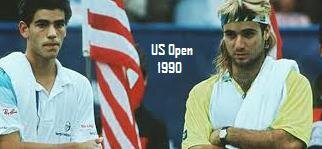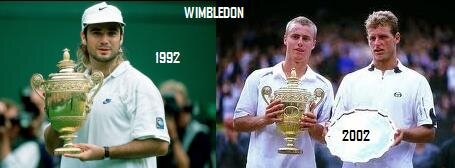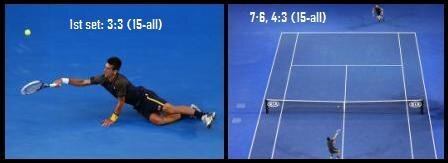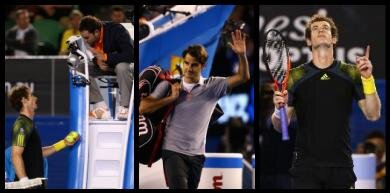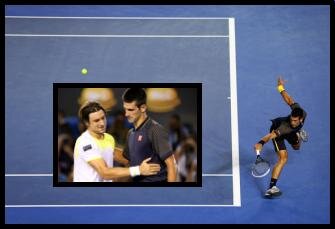My eBook
Categories
-
Recent Posts
| Wimbledon 1992 + 2002 |
Those Wimbledon tournaments are connected to themselves somehow. In 1992 Andre Agassi became the first baseline player since Jimmy Connors in 1982 to win the title at the All-England Club whilst Lleyton Hewitt was the first champion of this type since Agassi. Moreover finals in 1992 & 2002 were played between the youngest pairs, 22-20 & 21-20 years-olds.
At Wimbledon ’92 Andre Agassi and Goran Ivanisevic took their best shots to another level: the passing-shot and the serve respectively. They met in the final and thanks to their contrasting styles, one of the most memorable Grand Slam finals was made, in which passing-shots triumphed over serves by a small margin. 33-year-old John McEnroe, 15 years after his sensational Wimbledon semifinal, advanced to the last 4 once again (triumphed in doubles) and it was his swan-song at majors; in turn fellow American, Pete Sampras, the future seven-time Wimbledon champion, reached his first Grand Slam semifinal on grass; he never had been past the second round at Wimbledon in three previous attempts! Other future champion, Richard Krajicek made his controversial remarks considering women’s tennis. Read more…
Ten years later…
…a shift of paradigm in men’s tennis occurred: it’s a tournament that ended an era of serve-and-volley specialists. Prior to Wimbledon 2002, baseliners were always in minority as far as quarterfinals are concerned, that time there were as many as six baseline players in the last eight, and two of them advanced to the final making the first duel at that stage based on ground-strokes since 1978… Actually it was almost a surreal event: 8 out of 10 highest seeded guys dropped before the third round including an inexplicable Pete Sampras’ loss to George Bastl; three South Americans went through to the quarterfinals; David Nalbandian secured a place in the final playing his first main-level tournament on grass, not having played a match on Centre Court before the final! Under those bizarre circumstances 21-year-old Lleyton Hewitt was unstoppable – he won 6 out of 7 matches easily, and rather no-one had expected it would have been his last major triumph. Read more…
Posted in History
Leave a comment
7th week
This gallery contains 3 photos.
“Weekend for Old Men” paraphrasing a title of the Coen brothers’ movie. In every of three cities that hosted ATP tournaments this week, more than 30-year-old players triumphed in doubles (Frank Moser got his maiden title at the age of … Continue reading
| Roland Garros 1986 + US Open 1993 |
During John McEnroe’s sabbatical, Ivan Lendl seemed untouchable; in Paris ’86 he won his seventh tournament of the year, having obtained a final and semifinal in two other appearances (46-2 record). He worked out perfection in keeping concentration through long period of time, and notched amazing, 13-, 12- and 9-game-winning streaks respectively, in his last three matches of the event! It was a time of absolute Swedish ascendancy. T he Swedish tennis was producing new faces every year in the mid-80s. That year in Paris all four seeded Swedes surprisingly dropped before last 16, but popped out of nowhere two others in the second week: Ulf Stenlund – playing his first main-level tournament advanced easily to the fourth round (!) whilst Mikael Pernfors at his 17th event, stunned four seeds moving through to the final. Two-time Australian Open champion, 28-year-old Johan Kriek participated in his just second French Open, and surprised even himself reaching the semifinals. Read more…
he Swedish tennis was producing new faces every year in the mid-80s. That year in Paris all four seeded Swedes surprisingly dropped before last 16, but popped out of nowhere two others in the second week: Ulf Stenlund – playing his first main-level tournament advanced easily to the fourth round (!) whilst Mikael Pernfors at his 17th event, stunned four seeds moving through to the final. Two-time Australian Open champion, 28-year-old Johan Kriek participated in his just second French Open, and surprised even himself reaching the semifinals. Read more…
US Open 1993 – it was a tournament of bizarre occurrences: within one hour two out of four longest Grand Slam tie-breaks in history took place in the first round; in the fourth round Wally Masur won the only recorded Grand Slam match losing 0:5 in the deciding set; seeds were dropping like flies; finally a guy with an aluminum racquet (Prince Magnesium; it was a time when all players were already using graphite ones) 24-year-old Cedric Pioline, who had never won an ATP title, advanced to the final! Pete Sampras was above all, he was enjoying the best period of his career (extended from Key Biscayne ’93 to Rome ’94) and grabbed the second US Open title without serious troubles. Read more…
6th week
This gallery contains 2 photos.
A long-awaited Rafael Nadal’s arrival on tennis courts finally took place in Vina del Mar! Prior to this week the Spaniard didn’t enter any tournament since his sensational loss in the Wimbledon second round last year. It’s been the longest … Continue reading
Wimbledon + US Open, summaries 1968-79
Summaries 1968-79: Wimbledon + US Open
 Wimbledon and US Open in the 70s… tournaments dominated by two players: Jimmy Connors and Bjorn Borg, the tennis superstars who lifted in that decade the discipline onto a new level of popularity. They played four finals against each other out there: Borg won twice in London, Connors twice in New York. The Swede compiled a 38-3 record at Wimbledon in the 70s (four titles overall), Connors in turn, a 46-7 record in New York. These tournaments didn’t witness so consistent players in its venues for four decades! The Swede as the first man since Jean Borotra (finalist in years 1924-27) managed to reach four consecutive Wimbledon finals within a decade capturing three of them in a row as the first man since Fred Perry (1934-36) whilst Connors became the first man since Bill Tilden to play five consecutive finals in New York (Tilden played altogether eight in a row after the World War I)… In the meantime Rod Laver notched also four consecutive finals at Wimbledon (1959-62) and very likely he would have played a few more if he hadn’t abandoned his status of an amateur in 1963 that prevented him from participating in Grand Slam tournaments.
Wimbledon and US Open in the 70s… tournaments dominated by two players: Jimmy Connors and Bjorn Borg, the tennis superstars who lifted in that decade the discipline onto a new level of popularity. They played four finals against each other out there: Borg won twice in London, Connors twice in New York. The Swede compiled a 38-3 record at Wimbledon in the 70s (four titles overall), Connors in turn, a 46-7 record in New York. These tournaments didn’t witness so consistent players in its venues for four decades! The Swede as the first man since Jean Borotra (finalist in years 1924-27) managed to reach four consecutive Wimbledon finals within a decade capturing three of them in a row as the first man since Fred Perry (1934-36) whilst Connors became the first man since Bill Tilden to play five consecutive finals in New York (Tilden played altogether eight in a row after the World War I)… In the meantime Rod Laver notched also four consecutive finals at Wimbledon (1959-62) and very likely he would have played a few more if he hadn’t abandoned his status of an amateur in 1963 that prevented him from participating in Grand Slam tournaments.
Posted in History
Leave a comment
| Roland Garros 1980 + 2000 |
Bjorn Borg was a king of tennis in the late 70s and early 80s, he reached the peak of his stellar career at Roland Garros ’80. Prior to the event his 48-match winning streak was snapped, and in Paris another streak – this time extended to 21 wins – was initiated. During the fortnight, no-one even won five games in a set against him (!), Borg’s coach Lennart Bergelin admitted: ”I think we’ve reached the limit.” Two amazing Grand 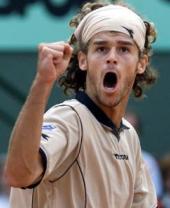 Slam comebacks of Jimmy Connors are often mentioned (Pernfors ’87, P.McEnroe ’91), but they wouldn’t be made if he hadn’t won a match in Paris that year against Jean-Francois Caujolle. Read more…
Slam comebacks of Jimmy Connors are often mentioned (Pernfors ’87, P.McEnroe ’91), but they wouldn’t be made if he hadn’t won a match in Paris that year against Jean-Francois Caujolle. Read more…
–
Even though Andre Agassi and Pete Sampras were seeded with two highest numbers, everyone expected a Gustavo Kuerten vs. Magnus Norman final. Agassi came to Paris out of form, with a humble 3-2 clay-court record, something similar had happened a year before when he triumphed, but tennis miracles rather don’t occur twice in a row, in turn Sampras had won just 2 out of 5 clay-court matches during his French Open preparation, and everyone knew he had lost his last reasonable chance to collect fourth Slam in Paris, in 1998. Much more younger Kuerten and Norman were brilliant at the time, sharing the biggest titles between themselves: Norman won the Italian Open, Kuerten in Hamburg, splitting wins against each other in the process. 20-year-old Marat Safin was considered as the only man who could interfere the general assumptions. Also other youngsters displayed their huge potential: Juan Carlos Ferrero, Roger Federer & Lleyton Hewitt. Read more…
Posted in History
Leave a comment
5th Week – Davis Cup (1R)
This gallery contains 9 photos.
First round 2012 Three notable players who had been nominated (Janko Tipsarevic, Nicolas Almagro, Radek Stepanek), skipped the weekend (injuries). Serbian fans should be happy Novak Djokovic didn’t follow suit despite his effort in Melbourne, last year he’d pulled out … Continue reading

